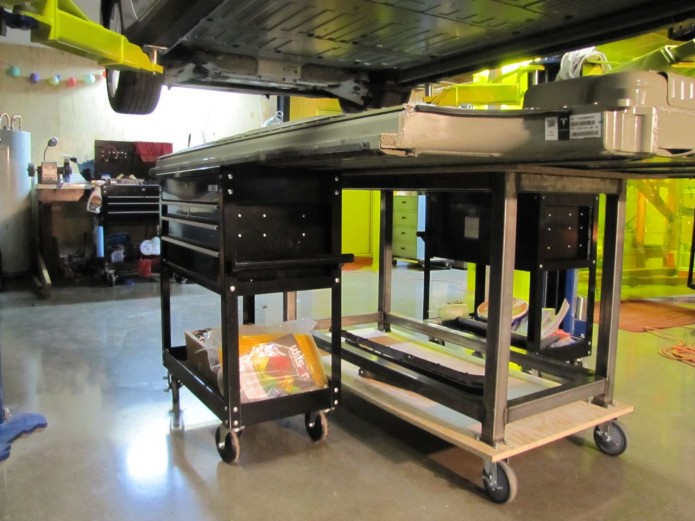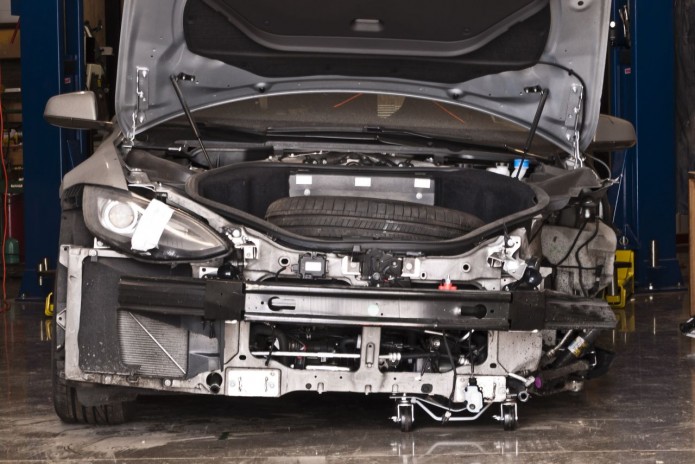What will it cost to do this anyway?
Do I hunt for a better deal, or make progress faster? That is often the question with a project like this one.
You may think that money is not an issue for someone who can afford to buy a Tesla, but we all have our limits and this project has been one to push my comfort zone. I suppose that that’s part of what makes it all interesting as well. I find it rather amusing to watch my initial resistance and then my justifications for spending funds along the way. Much of my life I’ve been concerned with money and here I’m strangely driven toward a large optional expenditure. It’s not like I’m concerned about making rent or food budget here, I’m very fortunate in that way these days, but this does involve what I would call considerable sums from what most people would suggest I’d do better to save for retirement.
It all started with getting the Tesla base vehicle. Six months ago when I started this project my budget seemed simple. I’ll buy a totaled Model S for $18K or so (seems about right for a luxury wreck), throw in a few grand to get the essentials running and then it will take much labor but very little cash to merge it with the stretched Vanagon body. Not pocket change, but not bad at all for such a cool EV. Ah grasshopper, you have so much to learn. After losing a couple auctions with my low bidding limit I reconsidered my budget. Had I not justified $30K for a battery pack on the conversion project this replaced? And is not $10K a perfectly reasonable amount for a powerful drivetrain? What about the value of a huge panoramic sunroof? That practically essential tech package? Don’t I need a test bed for high power AC drives in order to further my business? That retirement fund isn’t earning much anyway and besides this is going to be fun! I’ll sell a few vehicles to help with the cash flow and free up some work space as well. Within a few weeks I had talked myself into a $40K bid limit. Not that I’d need that much, no, I’m sure I’ll get one for $30K. Did I mention how I used to teach “Creative Justification 101”? I waited and watched some more. A number of less than ideal auctions went by with issues, no air suspension, the smaller 60 kWh battery, $50K selling prices, those were not for me. After over three months of auction watching my car showed up. The damage was not too bad, it had almost every feature I wanted, lacking only the dual onboard chargers, and best of all the passenger air bags were all intact so the interior was perfect. Very nice! Not only that, the pre bid value closed at only $12,300. It’s not uncommon for the final bid amount to be twice the pre bid, but not often much more than that. I thought long and hard about my bid limits for this car the night before the auction deciding I would go as high as $38,200 but not to my $40K hard limit. If I didn’t get it for that then I’d accept it was “not meant to be”, thereby giving my guardian angels a vote. Either I have a lesson to learn about expecting a good deal, or my guardian angels have a great sense of humor because the other bidders stopped at $38K and I won it for $38,100. As I watched it bid to $38K I knew I had to mentally let go, and even when I “won” it, I had to wait for the insurance to approve the sale since they had a $40K reserve, but I held tight and still won it. In the end auction fees, broker fees and shipping brought it to $42K.
$42K for a totaled car. What-Had-I-Done!? Prior to this, my most expensive car was a new Prius for about half that, and this one was a severe wreck. I just had to laugh. It started as a nervous laugh but now that the car has been here almost a month I can really laugh about how nutty it seems. Oh well, I reserve the right to do nutty things when I can, I guess it reminds me I’m alive. I’m grateful to have this freedom. The Stretch project in 1998 felt similar. Back then the front half was also the most expensive car I had bought by a factor of two and I promptly cut it up. It feels a bit like I’m trying to cut up my mental blocks. But this is not the end of those.
I think I got over the cost of the donor car. I’m still working on adjusting to the cost of luxury car parts. The steering rack mounting ears were broken in the accident. This is not uncommon in a wreck so you just replace the rack. I’m well accustomed to old Volkswagen prices and I normally pause a bit before I spend a few hundred dollars on a steering rack, but $3066.60 for one? This pause it taking longer.
Now I have a choice, do I buy a new rack or try for some alternative fix? Buying new is quick but costly. Alternatives take more time, carry more risk of lost time and money but can have hidden benefits. As a child I wanted a new go-cart, it was there in the Sears catalog and it would have been so cool! But buying a new go-cart was not an option in my family and so I had plenty of time to ponder alternatives. Eventually I built a much more creative go cart for almost no money and learned how to build things along the way. I’m not vouching for its safety, but I survived and gained valuable skills. I would have preferred the easy path of a new go-cart at the time, but the financial limitations forced me toward an education that my friends from wealthy families missed.
Back to the steering rack. If the Tesla were a few years older I might buy one from a wrecking yard for under $1000, but as of today I have not found a single Model S being sold for parts. A friend suggested having it welded so I took it apart. Now this part was fun, I’d never taken apart a modern EPS rack. If you are as curious as I am about these you can read about them here: It’s the high end Paraxial Servo Unit on page 8 and 9. I didn’t find this document until I had it apart, so I had the joy of discovering the fine brushless motor and belt, the integrated torque sensor and even how to put a few errant balls back in the recirculating ball gear before reading about them. With it apart I was able to take the housing to the finest aluminum welder in the region. He said there was a good chance he could weld it up, but complications such as the proximity of precision surfaces and my desire to run it on a heavy vehicle had me agreeing with him to look into other fixes first and only consider welding as last resort. The rack is made by ZF Lenksystems and with help from friends and Google we’ve found the cast housing may be the same as the one on a 2012 right hand drive Land Rover Evoque. There seem to be more of those in the scrap yards than there are Teslas. There’s one on eBay in the UK for $327, I’m awaiting more details from the seller to see if the housing is the same so I could swap it. Maybe this will work, but I’m warming up my justifications in case it doesn’t.
The steering rack is just the most expensive part. My list of parts to get it rolling comes to $8000.61 and I’m sure I’m missing some things. Many of the smaller parts are clearly worth buying but the air strut at about $1800 has me looking for alternatives as well. Eventually I’ll either find a workaround or get tired of looking for alternatives and just spend the money. I don’t want to wait too long to order parts since I hear Tesla parts sometimes have long lead times.
I wanted to write this post to let you know that I’m still working on it, even if it feels like nothing is happening on the outside. It may take some time to adjust my comfort zone, but with some minor delays the Stretchla will make progress.



































